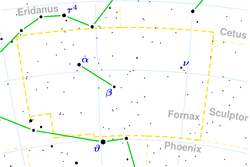天苑增三
(重新導向自天爐座α)
| 觀測資料 曆元 J2000 | |
|---|---|
| 星座 | 天爐座 |
| 星官 | 天苑(昴宿) |
| 赤經 | 3h 12m 04.5277s[1] |
| 赤緯 | –28° 59′ 15.425″[1] |
| 視星等(V) | 3.85[2] |
| 特性 | |
| 光譜分類 | F8IV[3] |
| U−B 色指數 | +0.082[4] |
| B−V 色指數 | +0.581[4] |
| 天體測定 | |
| 徑向速度 (Rv) | –20.5[5] km/s |
| 自行 (μ) | 赤經:371.49[1] mas/yr 赤緯:612.28[1] mas/yr |
| 視差 (π) | 70.24 ± 0.45[1] mas |
| 距離 | 46.4 ± 0.3 ly (14.24 ± 0.09 pc) |
| 詳細資料 | |
| 質量 | 1.33 ± 0.01[6] M☉ |
| 半徑 | 2.04 ± 0.06[7] R☉ |
| 表面重力 (log g) | 4.27[6] |
| 亮度 | 4.87 ± 0.16[7] L☉ |
| 溫度 | 6,240[6] K |
| 金屬量 [Fe/H] | –0.20[6] dex |
| 自轉速度 (v sin i) | 3.9[7] km/s |
| 年齡 | 2.9[8] Gyr |
| 其他命名 | |
| 參考資料庫 | |
| SIMBAD | 資料 |
天爐座α(α Fornacis, α For)是天爐座最亮的恆星,但只比4等星亮一點。中國傳統名天苑增三[9],它在西洋的固有名稱是Dalim (出自皮亞齊的星表Palermo Catalogue)[10][11][12]和Fornacis(在Burritt的星圖)[13]。這顆恆星最初的名稱是 波江座12。
天爐座α的光譜類型是F8IV,其中的IV表示它的亮度是在演化上已經離開主序星的次巨星[14]。它的質量比太陽重約33%,年齡是29億歲[6][8]。天爐座α是一對聯星 [15],有着高自行運動[2]。這個系統顯示出紅外過量,暗示可能有類似岩屑盤的拱星盤[16]
第二顆恆星已經被確認是顆藍掉隊星,它可能是合併了之前存在的第三顆恆星,或是累積了它的物質。它是個強X射線源,質量約為太陽的78% [17]。
這顆恆星的空間速度元件是(U、 V、 W) = (–35,+ 20,+ 30)km/s[18]。大約35萬年前,天爐座α星曾於A型主序星的時鐘座ν有過一次親密的接觸。估計曾互相接近至0.265 ly(0.081 pc)的距離,使這兩顆恆星都有岩屑盤[19]。
參考資料[編輯]
- ^ 1.0 1.1 1.2 1.3 1.4 Perryman, M. A. C.; et al. The HIPPARCOS Catalogue. Astronomy & Astrophysics. April 1997, 323: L49–L52. Bibcode:1997A&A...323L..49P.
- ^ 2.0 2.1 2.2 LHS 1515 -- High proper-motion Star. SIMBAD. Centre de Données astronomiques de Strasbourg. [2010-05-10]. (原始內容存檔於2016-04-13).
- ^ Favata, F.; Micela, G.; Sciortino, S. The [Fe/H] distribution of a volume limited sample of solar-type stars and its implications for galactic chemical evolution.. Astronomy and Astrophysics. July 1997, 323: 809–818. Bibcode:1997A&A...323..809F.
- ^ 4.0 4.1 Rakos, K. D.; et al. Photometric and astrometric observations of close visual binaries. Astronomy and Astrophysics Supplement Series. February 1982, 47: 221–235. Bibcode:1982A&AS...47..221R.
- ^ Evans, D. S. The Revision of the General Catalogue of Radial Velocities. Batten, Alan Henry; Heard, John Frederick (編). Determination of Radial Velocities and their Applications, Proceedings from IAU Symposium no. 30. University of Toronto: International Astronomical Union. June 20–24, 1966 [2009-09-10]. Bibcode:1967IAUS...30...57E. (原始內容存檔於2019-06-26).
- ^ 6.0 6.1 6.2 6.3 6.4 Santos, N. C.; Israelian, G.; Mayor, M. The metal-rich nature of stars with planets. Astronomy and Astrophysics. July 2001, 373 (3): 1019–1031. Bibcode:2001A&A...373.1019S. arXiv:astro-ph/0105216
 . doi:10.1051/0004-6361:20010648.
. doi:10.1051/0004-6361:20010648.
- ^ 7.0 7.1 7.2 Bruntt, H.; et al, Accurate fundamental parameters for 23 bright solar-type stars, Monthly Notices of the Royal Astronomical Society, July 2010, 405 (3): 1907–1923, Bibcode:2010MNRAS.405.1907B, arXiv:1002.4268
 , doi:10.1111/j.1365-2966.2010.16575.x
, doi:10.1111/j.1365-2966.2010.16575.x
- ^ 8.0 8.1 Nordström, B.; Mayor, M.; Andersen, J.; Holmberg, J.; Pont, F.; Jørgensen, B. R.; Olsen, E. H.; Udry, S.; Mowlavi, N. The Geneva-Copenhagen survey of the Solar neighbourhood. Ages, metallicities, and kinematic properties of ˜14 000 F and G dwarfs. Astronomy and Astrophysics. May 2004, 418 (3): 989–1019. Bibcode:2004A&A...418..989N. arXiv:astro-ph/0405198
 . doi:10.1051/0004-6361:20035959. See VizierR catalogue V/130 (頁面存檔備份,存於互聯網檔案館).
. doi:10.1051/0004-6361:20035959. See VizierR catalogue V/130 (頁面存檔備份,存於互聯網檔案館).
- ^ 伊世同 《中西對照恆星圖表》
- ^ Piazzi, G (編). Praecipuarum Stellarum Inerrantium Positiones Mediae Ineunte Saeculo XIX: ex Observationibus Habitis in Specula Panormitana ab anno 1792 ad annum 1813. Palermo. 1814: 21.
- ^ Kunitzsch, P. Arabische Sternnamen in Europa. Wiesbaden: Otto Harrassowitz. 1959: 155.
- ^ Laffitte, R. Héritages arabes: Des noms arabes pour les étoiles 2éme revue et corrigée. Paris: Librairie Orientaliste Paul Geunthner / Les Cahiers de l'Orient. 2005: 229.
- ^ Burritt, E. H. Atlas, Designed to Illustrate the Geography of the Heavens new. New York: F. J. Huntington. 1835. plate III.
- ^ Lopez, Bruno; Schneider, Jean; Danchi, William C. Can Life Develop in the Expanded Habitable Zones around Red Giant Stars?. The Astrophysical Journal. July 2005, 627 (2): 974–985. Bibcode:2005ApJ...627..974L. arXiv:astro-ph/0503520
 . doi:10.1086/430416.
. doi:10.1086/430416.
- ^ Söderhjelm, Staffan. Visual binary orbits and masses POST HIPPARCOS. Astronomy and Astrophysics. January 1999, 341: 121–140. Bibcode:1999A&A...341..121S.
- ^ Oudmaijer, Rene D.; et al. SAO stars with infrared excess in the IRAS Point Source Catalog. Astronomy and Astrophysics Supplement Series. December 1992, 96 (3): 625–643. Bibcode:1992A&AS...96..625O.
- ^ Fuhrmann, K.; Chini, R., Multiplicity among F-type Stars. II, The Astrophysical Journal, August 2015, 809 (1): 19, Bibcode:2015ApJ...809..107F, doi:10.1088/0004-637X/809/1/107, 107.
- ^ Gliese, W. Catalogue of Nearby Stars. Veröffentlichungen des Astronomischen Rechen-Instituts Heidelberg. 1969. Bibcode:1969VeARI..22....1G.
- ^ Deltorn, J.-M.; Kalas, P. Search for Nemesis Encounters with Vega, ε Eridani, and Fomalhaut. Ray Jayawardhana; Thomas Greene (編). Young Stars Near Earth: Progress and Prospects. ASP Conference Series 244. San Francisco: Astronomical Society of the Pacific: 227. 2001. Bibcode:2001ASPC..244..227D. ISBN 1-58381-082-X.
外部連結[編輯]
- α For (Dalim)(頁面存檔備份,存於互聯網檔案館) - SKY-MAP.ORG(頁面存檔備份,存於互聯網檔案館)
- LHL Digital Collections(頁面存檔備份,存於互聯網檔案館) - Linda Hall library(頁面存檔備份,存於互聯網檔案館)
| |||||||||||||||||
| ||||||||||||

